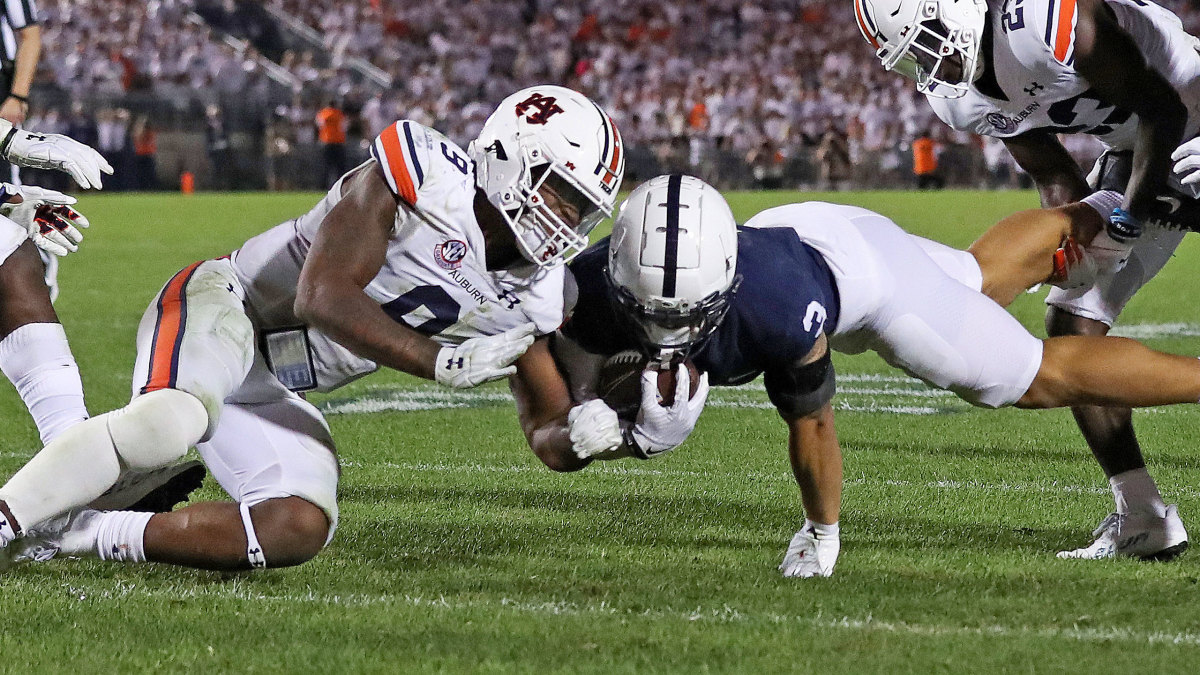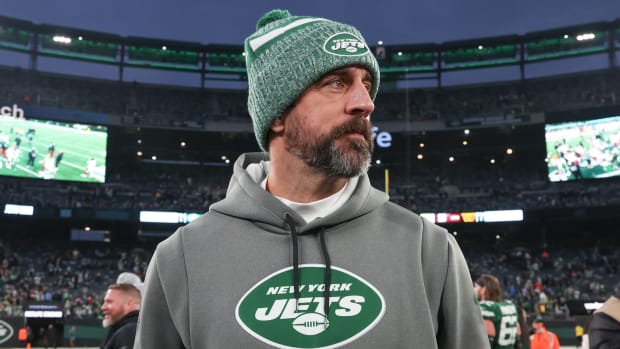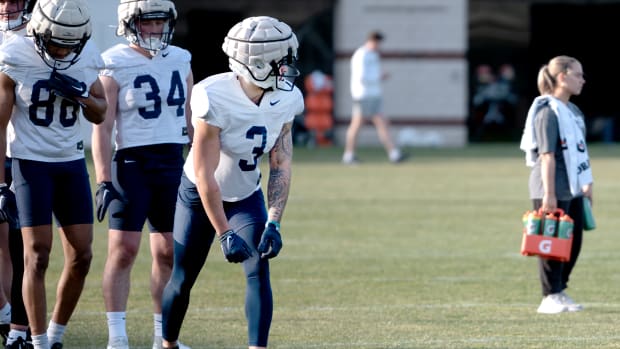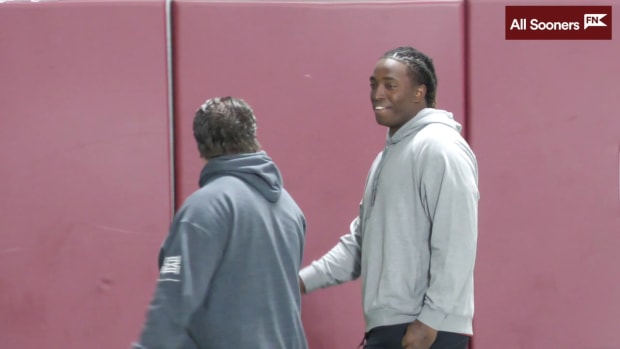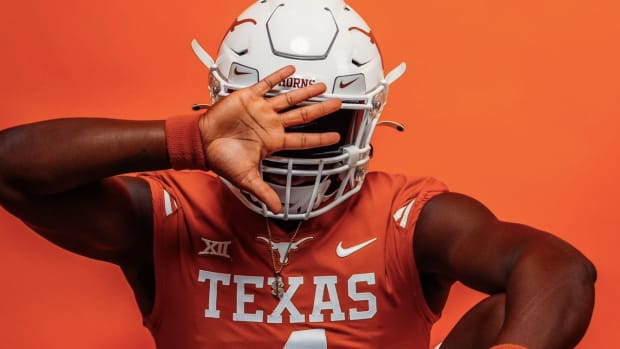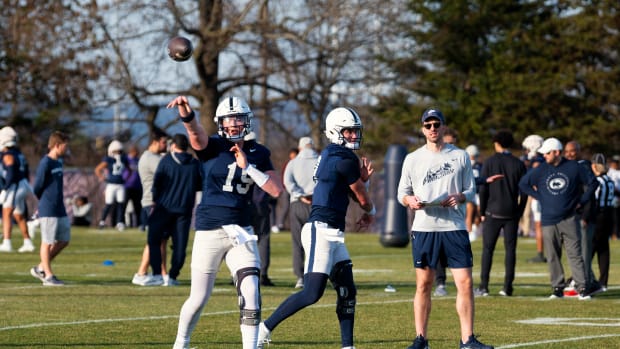As College Football's Targeting Debate Grows, Change May Be on the Horizon
In one of the biggest games of college football’s opening weekend this season, Penn State upended Wisconsin in a slobberknocker of a duel that evoked the sport’s greatest features: a raucous home crowd; a long game-winning completion; and a pair of game-securing defensive stands in the waning minutes.
While those highlights stirred college football’s feelings and helped usher in this return-to-normalcy season, one specific play from that game—a penalty, of all things—drew considerable buzz.
During Wisconsin’s critical fourth-quarter drive, quarterback Graham Mertz scrambled for a first down when he was met by Nittany Lions linebacker Ellis Brooks. Brooks smashed into Mertz in a vicious and loud collision, knocking him out of bounds with an act that is no longer permitted in the game. He lowered his head, launched his body and projected his helmet as a weapon, directing it into Mertz’s cap in a play that triggered a penalty: targeting.
Penn State was docked 15 yards, and Brooks experienced one of the more severe consequences in the game: He was ejected for the remainder of that half as well as the first half of the Nittany Lions’ next game.
In the television booth at the stadium, speaking to a national audience, Fox broadcaster Joel Klatt had a message for the sport.
“I just hate the ejection,” he said. “This is a problem with this rule. You gotta fix this, college football. It’s a disgrace.”
Well, they just might.
Among high-ranking college football leaders, there is movement afoot to at least consider an adjustment to the targeting foul’s most harsh individual punishment—the ejection. In fact, the NCAA’s own coordinator of officials, Steve Shaw, and a handful of conference commissioners as well as athletic administrators and coaches, expect the rule to be examined this offseason. By the time the 2022 season kicks off, the hope is that the policy looks different.
There is, however, a problem. At this point, a proposal does not exist to modify the rule that has universal agreement among the sport’s various bodies.
“I have not seen a sophisticated plan and structure,” SEC commissioner Greg Sankey says. “I will be the first to say I’m open to alternative approaches, but they have to be grounded in eliminating these hits. The ejection and suspension from the next half of a game is a fairly blunt instrument, but it makes the point to change behavior.”
In a Labor Day night game between Ole Miss and Louisville, four players were ejected, two from each team, for targeting fouls in the first half. It even triggered Rebels coach Lane Kiffin to take a shot at the officials during a halftime interview.
Two weeks later, Auburn defender Zakoby McClain was ejected for targeting after his helmet smacked a ball carrier’s helmet as he made a diving stop to potentially prevent a touchdown. McClain sounded off on Twitter a day later, suggesting that, maybe, he should have let Penn State receiver Parker Washington score.
The tweet drew more than 67,000 likes, indicative of the frustration among many in the college football community. Some of the most vocal critics are those on the broadcasts who, in many ways, represent a large segment of fan bases everywhere.
“Targeting makes me want to freaking scream!!!!!!!!!!!!!!!!!!!!!!!!” David Pollack, the former Georgia star and current ESPN analyst, tweeted recently.
College football’s executives understand how the penalty is perceived nationally—not well. Sankey says that industry leaders have not effectively communicated the rule to the masses.
Why is the rule there in the first place?
What is the rule exactly?
And how has the rule prevented serious injury?
“Targeting is a play where there is high-speed, head-to-head contact,” says Doug Aukerman, a long-time athletic physician and associate athletic director at Oregon State who chairs the Pac-12’s medical advisory board. “It has all the characteristics of what you’d consider a dangerous play with possible head trauma. It’s a big concern for concussions. The rule is put in place to remove a risky play.”
Targeting—the current rule and ejection policy implemented in 2013—is derived from the spearing penalty, when a player launched helmet first into another. The penalty is much more complicated than that now. In fact, targeting is a two-pronged foul and each of those prongs features its own elements.
Targeting A, we’ll call it, is targeting a defenseless player. Elements needed: (1) a defenseless player, such as a quarterback in the pocket or a receiver catching a pass across the middle; (2) indicator of targeting, such as a launch or thrust, a lowering or leading of the head; and (3) forcible contact to the head or neck area. Targeting A is typically helmet-to-helmet contact, but not always. A forearm to the head of a defenseless player meets the condition of the rule.
Targeting B is leading with the crown of the helmet. The primary element needed here is targeting your opponent with the crown—top—of the helmet to any body part.
Targeting A is often easily identified by fans and others. Targeting B, not so much. Targeting B protects the giver of the blow as much as the recipient. Forcible contact into the crown of the helmet can often lead to serious neck injuries.
“Most fans can see and get a defenseless player targeting,” says Shaw, in his second year as the NCAA coordinator of officials. “The crown of the helmet [targeting], it’s more difficult to see, but it may be the most dangerous one.”
Over the years, the rule has been modified. In 2016, officials voted to confirm each targeting call with replay, and in 2019, they adjusted the review protocol requiring all elements of the rule be confirmed in order to uphold the targeting, something that increased the number of fouls overturned.
Through the first three weeks of the 2021 season, officials called targeting 105 times. However, 45 of those were overturned on replay. Sixty targeting fouls were enforced in 243 games for a rate of 0.25, or one targeting call every four games. That is in line with last year’s data (0.27), which featured the highest targeting rate since at least 2016, when there was a targeting foul enforced in about every six games (0.17).
By regularity rate among all fouls, targeting ranks about 15th, or in the top one-third percentile, says Shaw, well behind leaders like false start (2.5 a game) and offensive holding (2.4). But no other penalty comes with such a severe consequence, especially a foul that even Shaw acknowledges features an element of subjectivity and judgement, such as pass interference.
“We call them gray plays,” he says. “We are trying nationally to get every replay official consistent.”
It’s the punishment, not the penalty, that has college football fans and even some of the sport’s leaders exploring modifications.
“It’s an unbelievably costly penalty to young people. Every game, I’m heartbroken for those kids,” says Todd Berry, executive director of the American Football Coaches Association. “It’s time for us to try something different.”
Berry is far from alone in his thinking.
“We’ve got to get our arms around that,” says Craig Thompson, the longtime commissioner of the Mountain West. “One man’s opinion: It’s extremely punitive to take away a half of football.”

Former Ohio State QB Justin Fields was on the receiving end of a targeting hit during last season's playoff semifinal.
Russell Costanza/USA TODAY Sports
In the next few weeks, a study on targeting and concussions is expected to be published. It will reveal stunning data connecting the foul with head injuries.
Simply put, says Aukerman, targeting incidents produce an incredibly high amount of concussions.
“Medically,” he says, “the targeting penalty is an important rule for player safety because it is a high-risk play.”
Nearly a decade into the targeting era in college football, medical experts and the sport’s executives are seeing a change in behavior as a result of the targeting rule.
Sankey himself says he’s witnessed individual SEC teams over the years drop from a half-dozen targeting calls in one season to zero the next year, proof that coaches are teaching the technique and players are carrying out that instruction, most important of which is to keep your head up.
But is behaviour changing because of the 15-yard penalty? Or because of the ejection?
Last year only nine players committed multiple targeting fouls during the season: seven committed two and two players were flagged three times. Those who commit a third targeting foul in a single season are suspended one game. “That’s an indicator, the small numbers, that the rule is working,” Shaw says.
However, targeting’s increase in rate over the last two seasons may be a sign that it is becoming more and more difficult for players to abide by the rule in an evolving sport, says Berry. Targeting has changed individual behavior as well as the plane in which the sport is played. Coaches are noticing that the game is played at a much lower level than in years past, a result, they say, of rules prohibiting hits to the upper torso.
As the game gets lower and lower, it becomes more difficult for a player to keep his head up, Berry says. What’s left is a slew of accidental targeting fouls that end in ejection.
It’s why Berry and the coaches’ association believe targeting should be a two-part penalty. His proposal would create a Targeting 1, which would result in only a 15-yard penalty. Targeting 2, a more malicious hit with intent to strike an opponent’s head, would carry a 15-yard penalty plus the standard ejection.
Several athletic administrators who serve on various NCAA governance committees agree as well—the two-part penalty is the way to go. “There is a significant amount of support for it,” Berry says.
But not everyone is on board.
A two-part foul injects extra subjectivity into the rule, making an official’s job more difficult. They’d spend more time dabbling in the gray area, attempting to determine whether a player had malicious motives.
“I don’t know how you determine intent,” says MAC commissioner Jon Steinbrecher, who supports an examination of the rule. “The foul has nothing to do with intent.”
A tiered system could devolve into what’s experienced with the NBA’s two-tiered flagrant foul structure, where a large portion of flagrants are deemed as the less-punitive Flagrant 1. If you move to a two-tiered targeting foul, does it tremendously weaken a penalty that is made to prevent head trauma?
College football has experience with tiered penalties. Remember the five-yard facemask vs. the 15-yard facemask? That went away more than 10 years ago. There still exists some of them, such as running into the kicker (5 yards) vs. roughing the kicker (15 yards).
Sankey questions whether a tiered targeting rule would work.
“People can say, ‘Well that was a football play!’” he says. “The brain and the neck don’t realize that’s just a football play or that was level one or that was level two play. What about if somebody received a blow to the head and can’t play for two weeks?”
In a way, that’s an ejection, Sankeys says, and yet the giver of the blow returns to the game?
“It’s not just the recipient of the blow,” he says. “I watched a defender strapped to a board last season carted off after delivering one of those blows.”
In the NFL, the penalty for targeting is at the discretion of commissioner Roger Goodell and normally results in a financial penalty—not disqualification. College football does not have the ability to fine players and thus “playing time is a direct way to access accountability,” Sankey says.
But can it be accessed in a smaller amount and still curtail head-hunting behavior?
Right now, the ejection policy can be inconsistent depending on the timing of the ejection. The rule calls for a player to be suspended from the remainder of the half in which he’s flagged as well as an additional half. A player flagged in the first three minutes of a game is suspended for what amounts to a full game. However, a player flagged in the final minute of a game would be suspended for only the first half of the next game.
Thompson, the Mountain West commissioner, suggests suspending a player for one full quarter. There are other options too, suggested by those within the sport. Maybe a player is ejected for the rest of the game in which he is playing, eliminating the policy from impacting another game. Maybe a player is only ejected if he is flagged for a second targeting in the same game.
Or does the language in the rule need massaging? The NFL, for example, makes an exception for inadvertent or incidental contact with the helmet and/or facemask in its targeting rule.
Watch NCAA football games online all season long with fuboTV: Start with a 7-day free trial!
Either way, scaling back the rule is a concern for some authority figures in the sport. After all, targeting was introduced in college football in response to pressure from Congress as it relates to concussions. Concussion lawsuits are still very much active.
Liability is an issue.
“I think the rules committee is wide open,” Shaw says. “There is discussion about, ‘Do we need to change this penalty?’ We have to maintain the focus on player safety and continue this journey of modifying player behavior. Whatever we change, we can’t back up on those. But the timing is right to talk about the penalty component.”
And so here is college football, in quite the quandary. Frustrations are bubbling over. Questions are being hurled. It’s not only from fans, coaches and players either.
Jeff Dugas, Troy’s team doctor, is an orthopedic surgeon in Birmingham who chairs the Sun Belt’s COVID-19 advisory panel and has spent time on NCAA governance committees. While he believes the targeting foul is protecting the game and is not materially changing the sport, he’s a member of a large and growing club: people who are at times confused by certain targeting calls.
A specific scenario vexes him: When a defender’s head hits an offensive player’s helmet only because the offensive player made a last-minute move.
“You can’t fault the defensive player for that,” Dugas says. “They’ve got to create a different class for that. Is it even a penalty? What does the defensive player do in that scenario?”
It’s a fitting comment. While modifications to the targeting foul feel imminent, there are more questions than answers right now.
“I don’t know the solution,” says Thompson, “but we need to take a different look at it.”
Targeting By the Numbers
Through the first three weeks of the college football season.
• Targeting fouls called: 105 (45 overturned on replay)
• Targeting fouls enforced: 60
• Average targeting foul enforced per game: 0.25 (or one every four games)
Targeting fouls per game over the last five years.
| YEAR | PER GAME |
|---|---|
2016 | 0.17 |
2017 | 0.23 |
2018 | 0.26 |
2019 | 0.19 |
2020 | 0.27 |
More College Coverage:
• What a 12-Team Playoff Would Look Like After Week 4
• SI Top 10: Arkansas Win Shifts Chaotic Landscape
• Clemson's Second Loss Provides Needed Jolt of Parity
Sports Illustrated may receive compensation for some links to products and services on this website.
